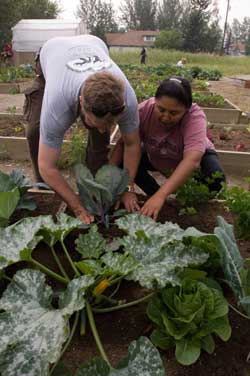The behavior changes that we seek from Extension’s interventions only arise once program participants learn something new: through our programs they gain knowledge, skills or awareness. For example, the Alaska Extension client below is learning how to plant a community garden. (Photo by Edwin Remsberg USDA/CSREES.)
The diagram that I usually use to illustrate a public value message leaves out this “learning” step. In two recent public value workshops–for Texas Agrilife Extension and for Missouri Extension–I presented the public value message diagram slightly differently than I have done before.

Many of us document the learning step in our logic models. End-of-workshop evaluations and follow-up evaluations often measure the increases in knowledge, skills, and awareness. And for program evaluation, that step will continue to be crucial. For a public value statement, however, I tend to de-emphasize the learning step. Because I think that stakeholders are more interested in what happened, as a result of the learning, I like to move quickly to the behavior changes, outcomes, and public value a program generates. Learning is part of the mechanism that gets us to public value, but it is not the end in itself.
What do you think? Should a public value message keep the learning step implicit, or should it receive more emphasis when we communicate with stakeholders? Do you think the (not very dramatically) altered public value message diagram is a helpful tool or an unnecessary distraction?
